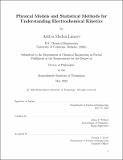Physical Models and Statistical Methods for Understanding Electrochemical Kinetics
Author(s)
Limaye, Aditya Madan
DownloadThesis PDF (9.428Mb)
Advisor
Willard, Adam P.
Terms of use
Metadata
Show full item recordAbstract
Decarbonization of the global economy in order to limit rapid global surface temperature growth is a critical industrial and societal challenge for the next several decades. Yet, several sectors of the economy remain stubbornly difficult to decarbonize, such as commodity chemicals production, cement and steel manufacturing, and synthetic fertilizer synthesis, to name only a few. Emerging efforts to decarbonize these processes rely on electrochemical techniques, which use emissions-free sources of electricity to drive relevant chemical reactions. Much remains to be understood about the fundamentals of electrochemical kinetics, hampering efforts to rationally engineer decarbonized electrochemical processes. This thesis develops new physical models and applies rigorous statistical methods towards developing a more complete understanding of electrochemical kinetics.
The physical models I develop are grounded in the framework of classical statistical mechanics. In Chapter 2, I develop an extension to the classical Marcus kinetic theory of electron transfer that accounts for diffusive transport effects in the electrochemical double layer. In Chapter 3, I advance a simple physical explanation for why the reorganization energy, a key parameter in Marcus theory, exhibits marked attenuation upon approach to a constant potential electrode surface. Finally, in Chapter 4, I apply molecular dynamics simulations of the electrochemical double layer (EDL) to evaluate the fidelity of continuum theoretical predictions of electrostatic potential variation in the EDL.
The statistical methods I report in this thesis leverage relatively straightforward mathematical approaches to modernize classical electrochemical analyses. In Chapter 5, I show how applying a Bayesian analysis technique to Tafel slope analysis can correct subjective human biases in literature-reported analyses of CO2 electroreduction data. Finally, in Chapter 6, I develop a new electrochemical analysis technique based on analysis of weakly nonlinear current response to a medium-amplitude oscillating voltage signal, which can serve as a complementary technique to cyclic voltammetry, a more traditional approach to electrochemical characterization.
Date issued
2022-05Department
Massachusetts Institute of Technology. Department of Chemical EngineeringPublisher
Massachusetts Institute of Technology